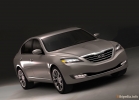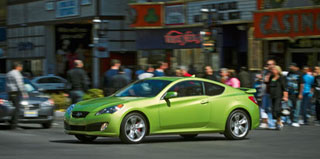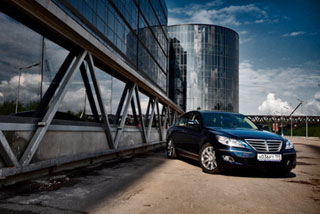Hyundai Genesis test drive since 2008 sedan
Obvious and incredible: Hyundai Genesis Coupe is better than Infiniti G37
 Student beauty against proven power
Student beauty against proven power In fact, a list of worthy 6-cylinder sports coupes is short. More precisely, until now it included only the BMW 335i and Infiniti G37. And then, somewhere in early February, Hyundai threw off the bomb, and the atomic one.
It is called Hyundai Genesis Coupe 2010 model year.
Quite suddenly, the Korean car manufacturer, whose previous attempts to create sports cars include, for example, an unenviable Scoupe and the forgotten first generation of Tiburon, was in the spotlight with a new model, which has both an attractive appearance and the necessary data for accomplishing feats. 300 horsepower. 6-speed manual gearbox. Rear drive. Differential for increased friction. So you can forget about your scoupe. The time has come for a real car.
It sounds as if we are talking about entering the territory of Infiniti G37, right? And it is true. By all aspects, except for the cost. So, you have a comparative test.
How much is the races now?
Hyundai Genesis Coupe 3.8 of 2010 model year A solid car with a sufficient supply of power, excellent style and low price. Really low.
For $ 29,500, you can buy a Genesis with a 6-cylinder 3.8-liter engine and a set of Track equipment, which consists of a stiffer suspension, a differential of high friction type, Brembo brakes and 19-inch wheels. The 6-speed manual gearbox is included in the basic configuration, and our tested Genesis is equipped with it. Together with rugs, a connector for the iPod and delivery, the car cost $ 30,375. And this, by the way, is $ 6,625 less than the cost of a drain Infiniti G37.
But let's not immediately exclude the G37 from the game. After all, he turned out to be brave enough to win many comparative tests.
Our test G37 is simply stuffed with options: Premium package for $ 3 200 includes an audio system Bose, a driver's seat with memory function, Bluetooth and other useful little things. The navigation kit cost $ 2,200, the rear spoiler costs $ 550, and the illumination overlays on the door thresholds added another $ 330 to the cost.
In total, the Infiniti G37 of the 2009 model year with a similar 6-speed gearbox was spent $ 44,095, including delivery.
Comparison of specifications
So, closer to business. Both cars are expensive. Just the G37 is much more expensive, that's all. But Infiniti, the specification is more impressive. Its 3.7-liter 6-cylinder engine has a power of 330 hp. And it develops the torque of 366 Nm. The G37 has huge 19-inch wheels with Bridgestone Potenza sticky summer tires, and the stationary 4-piston brake calipers are combined with 14-inch front brake discs. However, Genesis is also able to fend for itself, having a 3.8-liter V6 engine with a theoretical power of 306 horses and a torque of 360 nm. He also has 19-inch wheels and the same Bridgestone summer rubber, and Brembo 4-piston calipers are in harmony with 13.4-inch brake discs.
Is the G37 of additional functions, power and reliable chassis enough to defeat the competitor, who, in life and in theory, seems to be ready to repel the frontal attack?
 This is what we thought about during two weeks of testing both machines. We tried them on moist roads, on a dynamometric stand and a snake snake, we even penetrated on close rear seats. From the very beginning, we decided that the cost and running qualities will have the same weight when setting a final estimate (25%each). The rest of the points will be made up of the level of configuration (15%), our estimate according to predetermined parameters (15%), fuel economy (15%) and the views of the editorial office (5%).
This is what we thought about during two weeks of testing both machines. We tried them on moist roads, on a dynamometric stand and a snake snake, we even penetrated on close rear seats. From the very beginning, we decided that the cost and running qualities will have the same weight when setting a final estimate (25%each). The rest of the points will be made up of the level of configuration (15%), our estimate according to predetermined parameters (15%), fuel economy (15%) and the views of the editorial office (5%). On road
If the essence of this competition was reduced only to assessment of controllability, the victory would have gone to the Infiniti G37. This car goes better. Its suspension provides a more optimal compromise between comfort and sharp control, the engine is more consistent with the nature of the sports compartment, and control devices are of a better reaction. Even his steering wheel, which at first seems too tight, comes to life and tells the driver accurate information about the adhesion of the front wheels with the road on the turns. This advanced formula Nissan uses on all its cars along with the FM platform (Front-Midship engine is located behind the front axle).
The VQ series engine is a good argument in favor of the purchase of Infiniti. With a breathtaking margin of revolutions (cutting is installed at a mark of 7,600), the car lives on speed in a wide leg, and not just survives (we were convinced of the correctness of this impression on the dynament). Such performance is better for fast driving than Genesis grumbling mill. Rising uphill and singing a melody, you will find that the turns often increase quickly. And you will want to have an engine that can cope with such a task.
Perhaps the only aspect by which the Infiniti G37 is inferior to the Genesis'y is the use of a differential based on WiSoft. It is characterized by a slower reaction, and hence less predictability than the differential of torsen in Genesis. Thus, the Nissan Wissan Wissan is simply not effective for the potential of such a machine.
Still, no one will deny that Genesis is very, very good. In fact, most drivers would not miss the increased level of information content of the G37, unless they get to experience the Hyundai with Infiniti. The steering wheel and brakes Genesis are lacking the speed of the G37 reaction, but still they inspire confidence. The speed switch does not work as accurately as the bolt of the rifle, but we have never mistaken with the choice of transmission.
Well, as for the Korean 3.8-liter engine ... Under the hood, the heart of Minivan beats, and we cannot pretend that this is not so. We are ready to swear, behind the laryngeal voice of the air intake, which sounds much better than the creaky howls of the G37, the baby Kia Sedona is still hiding. But let's not forget that this Korean engine is slightly larger than the Infiniti unit. Genesis 6-cylinder engine starts without delay and catches up or even exceeds the Infiniti engine in power and the development of torque to 4,800 revolutions, which is indicated by the Dynamometric stand in the MD Automotive workshop in California (video from the dynamo dough can be viewed here ).
 Protection from a fool or an unreliable transmission?
Protection from a fool or an unreliable transmission? On the track, Hyundai Genesis demonstrates a worthy entry in the sports coupe segment and makes an expensive Infiniti sweat in order to pass several tests. First of all, the Genesis weighs only 1,582 kg per 100 kg less than the G37. Obesity has long been considered a significant drawback of any car with the Nissan FM platform, and the model G is not an exception.
But the light weight did not help Genesis'y to accelerate as fast as expected. Speeds 60 miles/hour (96 km/h) it reaches in 6.4 seconds and drives a distance of 402 meters in 14.5 seconds, showing a speed of 157.55 km/h on cutting. And this is much slower than the G37, in which acceleration takes 5.7 seconds. 402 meters Infiniti drives in 13.9 seconds, reaching a speed of 163.18 km/h.
Quick acceleration on Genesis'e is difficult due to the transmission protection system, which is provided by engine settings. If you switch the gears faster, sometimes the torque in the selected gear can completely disappear for 3 seconds.
This problem is aggravated by the quality of the tachometer, which in the first gear does not have time behind the speed of the engine, so it is easier to disperse the engine to its maximum of 6,800 rpm (although the red zone begins at 6,500 revolutions). The manufacturer of Hyundai claims that the transmission protection is activated at 6,800 revolutions, but as soon as this happened, we felt a decrease in power in the next gear with much lower engine speed. You can spin this V6 before cutting off in any gear, and the motor will feel great. But if you quickly and abruptly switch and reach the specified limit, you may be able to punish in the form of such a power outage.
Hyundai plans to change the settings, but cars with this 3-second interruption are already being sold. Such a setting can punish even those drivers who do not disperse the engine to the limit at all. Some will not notice this, but someone will force this circumstance to refuse to purchase the Genesis 3.8 compartment.
History of management
Both coupes adequately respond to pressing the gas pedal, which allows you to adjust the passage of turns on the circular site. But Genesis's differential allows you to perform these actions faster and more confident. This differential also provides the best lateral acceleration than the G37. So, on the circular platform, Hyundai shows the indicator 0.88G, and the G37 0.85G.
On the snakes, the more tight steering wheel G37 is very informative, which helps to make reasonable decisions without dropping speed. But Genesis allows you to better control the roll, and its information content is more than enough to feel dimensions. Infiniti overcomes this task at greater speed than Genesis (112 and 110 km/h, respectively).
In reality, the story is not limited in numbers. Try to drive on these cars in the same areas, and you will find that their abilities are equal. From one you can squeeze a higher speed at the exit from the turn, the other will show great confidence here. You will fall in love with the invariable reaction of the G37 brakes, and then you are fascinated by a calmer, but to the same extent confident behavior of the Genesis pedal. With a quick ride on the Hyundai Genesis, its laryngeal grumbling is heard, the predictability and exemplary balance of the rear -wheel drive is felt. For comparison, Infiniti is more restless, accurate and prompt.
In this case, both approaches are good. But if we go into the subtleties, we believe that the Infiniti G37 is less suitable for everyday trips, during which its tight steering wheel and a quick reaction of the brakes seem useless, and sometimes even uncomfortable. Then it is also worth noting that the mounting of the Genesis coupe engine is too soft, so its huge V6 is too strong when jerking and braking, creating annoying shocks in transmission. But we will not criticize them too much, because, in principle, we like the settings of both cars.
 Inside and outside
Inside and outside The quality of the interior and the Hyundai design demonstrate superiority over many relatively expensive cars, but if you take into account a car that costs as much as the G37, you can understand what it was saved on.
There are two additional rotary regulators on the central console G37, which, as you know, are more expensive and provide more optimal and operational control than conventional buttons. The G37 has another such switch that regulates the temperature for the passenger. For Infiniti, climate control is standard equipment, Genesis does not have such an option. Another key is provided for radio. High -quality control of the radio and air conditioning characterizes both cars, but there are nuances of the buttons in Infiniti are more accurate and better depreciation.
Infiniti navigation package costs $ 2,200 and includes one of the best navigation systems of business class, as well as the XM NAV Traffic software, 9.3 gigabytes of memory on a hard drive for music and a USB-extension for playing files in MP3 format. On Hyundai navigation will appear only from the middle of the model year.
However, Hyundai seats did not stint. In truth, the only thing that comes to mind on the topic of their improvement is to finish the surface of the seats with non -slip material. Otherwise, they have good side support, are adjusted and even look good. And they are better than seats G37 in all respects, except for one, landing on the front seats is difficult, which does not sin in infiniti
Once in the rear seat of Genesis, passengers with a height of more than 160 cm will have to bend, and in the G37 they will still fit. Both cars offer compromises in terms of the rear seats, which does not at all have long trips to them in both cars.
And finally, if something can force to see angularity and heavyness in the G37, it is an aggressive image of the Genesis compartment. This is a really beautiful machine, the outlines of which literally stop the movement. And an outstanding buyer will choose a black color for his Genesis, which will best emphasize his spectacular arches and sculptural sides. Hyundai designers managed to adopt the elegant G37 proportions and add several missing elements of the form. And we liked the car.
Conclusion
An irrefutable equation of values \u200b\u200binclines us in favor of the Hyundai Genesis 3.8. By purchasing this compartment, you just get more car for your money. Of course, it will not be identical to Infiniti G37, but for two -thirds of the cost this cannot be.
In addition, Hyundai opens up the door to the world of a sports coupe for a new buyer for someone who is not ready to spend almost $ 50,000, but still wants to get the appearance and main possibilities of steep cars. Thus, the Hyundai Genesis Coupe 3.8 can easily become the main item in the list of possible purchases.
As a result of the test, the first place went to Hyundai Genesis. Being a spectacular and skilled car, the Genesis compartment offers an exemplary rear -wheel drive at a favorable price. The powerful, reliable and expensive G37 is on the top above ... That's just not proportional to its immodest value.
The results of the test
Weight Hyundai Genesis Coupe V6 3.8 6MT Infiniti G37 Sport 6MT
Subjective rating 2.5% 83.3 66.7
The rating must be taken! (Which of the cars from the point of view of the editorial office is better for the average buyer in this machine segment) 2.5% 100 50
Assessment for 28 pre -agreed points (from the characteristics of the engine to the convenience of the rear seats) 15% 76.8 80.1
Equipment 15% 33.3 60
Driving qualities 25% 86 99
Fuel consumption 15% 100 100
Price 25% 100 54.8
Total score 100.0% 82.6 77.4
Final rating 1 2
Note. Comparative Infiniti G37 and Hyundai Genesis Coupe test on the track was made by INSIDELINE journalists in early February. The Korean compartment in the framework of testing showed not the best results that disappointed both the representatives of the Insideline and the Hyundai specialists. After the tests, three main problems were discovered with the test model of the Genesis model:
1) on the rear axle adjustment of the angles of the installation of the wheels was incorrect;
2) worn tires were used on the front axis of the machine, while completely new tires stood behind;
3) The electronic control unit of the engine (ECU) was configured to protect the transmission from damage, so he did not allow reporters to use all the capabilities of the gearbox.
After a month, Hyundai made some changes to the Genesis electronic control unit, thanks to which the problem of gear shifts has gone. Genesis Coupe with the updated ECU and good tires was again transferred to reporters who were able to get completely different results on it.










A source: Autozeitung.de











